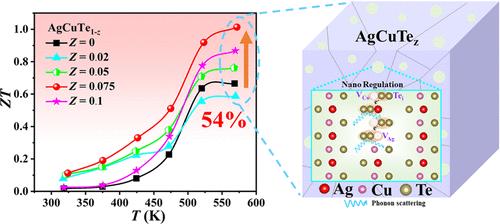AgCuTe 热电材料中含碲间隙原子和银/铜空位的纳米级区域的高密度排列
IF 5.4
3区 材料科学
Q2 CHEMISTRY, PHYSICAL
引用次数: 0
摘要
AgCuTe 中 Te 离子的刚性晶体亚晶格提供了有效的电传输通道,使 AgCuTe 表现出良好的电学特性。然而,在 Te2- 刚性阴离子框架中出现空位或间隙原子在理论和实验上都提出了重大挑战。在这里,我们首次发现了 AgCuTe 相中存在局部 Tei、VCu 和 VAg 多重缺陷,以及 AgCuTe1-z 样品的 Cu2Te 相中存在高度有序排列的 VCu。这些局部缺陷的形成是由于在制备过程中过量析出了 Ag 和 Cu,从而增强了声子散射并降低了热导率。同时,AgCuTe1-z 样品中阳离子的总含量相对于阴离子有所增加,从而优化了固有空位和载流子的总浓度。因此,与原始 AgCuTe 相比,室温下的功率因数提高了 311%,晶格热导率降低了 44%,ZT 净值提高了 54%。这种方法有望成为增强其他碲基阴离子框架超离子导体材料热电性能的通用改性策略。本文章由计算机程序翻译,如有差异,请以英文原文为准。

High-Density Arrangement of Nanoscale Regions with Tellurium Interstitial Atoms and Silver/Copper Vacancies in AgCuTe Thermoelectric Materials
The rigid crystalline sublattice of Te ions in AgCuTe provides an effective electrical transport channel, enabling AgCuTe to exhibit good electrical properties. However, the appearance of vacancies or interstitial atoms within the Te2– rigid anionic framework poses significant challenges both theoretically and experimentally. Here, we are the first to discover the existence of localized Tei, VCu, and VAg multiple defects in the AgCuTe phase, as well as a highly ordered arrangement of VCu in the Cu2Te phase of AgCuTe1–z samples, by only fine-tuning the Te stoichiometric ratio. The formation of these localized defects arises from the excess precipitation of Ag and Cu during the process, which enhances phonon scattering and reduces thermal conductivity. Simultaneously, the total cation content in AgCuTe1–z samples increases relative to the anion, thereby optimizing total intrinsic vacancies and carrier concentration. As a result, there is a 311% increase in the power factor and a 44% decrease in the lattice thermal conductivity at room temperature, leading to a 54% net increase in ZT compared to that of pristine AgCuTe. This approach is expected to be a universal modification strategy for enhancing the thermoelectric properties of other Te-based anionic framework superionic conductor materials.
求助全文
通过发布文献求助,成功后即可免费获取论文全文。
去求助
来源期刊

ACS Applied Energy Materials
Materials Science-Materials Chemistry
CiteScore
10.30
自引率
6.20%
发文量
1368
期刊介绍:
ACS Applied Energy Materials is an interdisciplinary journal publishing original research covering all aspects of materials, engineering, chemistry, physics and biology relevant to energy conversion and storage. The journal is devoted to reports of new and original experimental and theoretical research of an applied nature that integrate knowledge in the areas of materials, engineering, physics, bioscience, and chemistry into important energy applications.
 求助内容:
求助内容: 应助结果提醒方式:
应助结果提醒方式:


